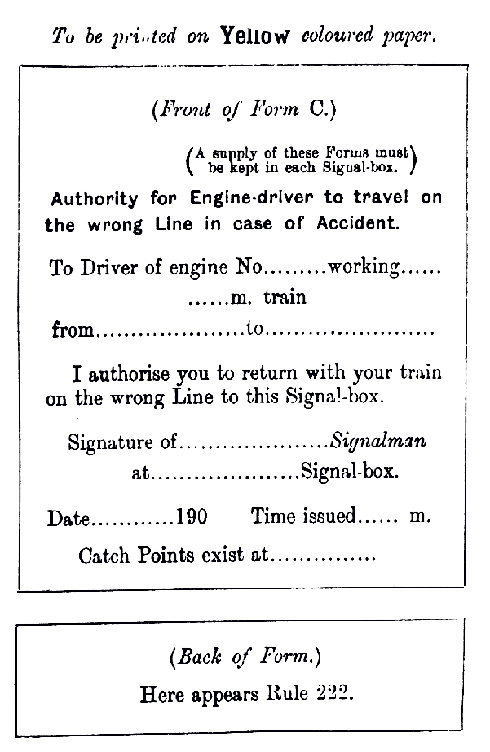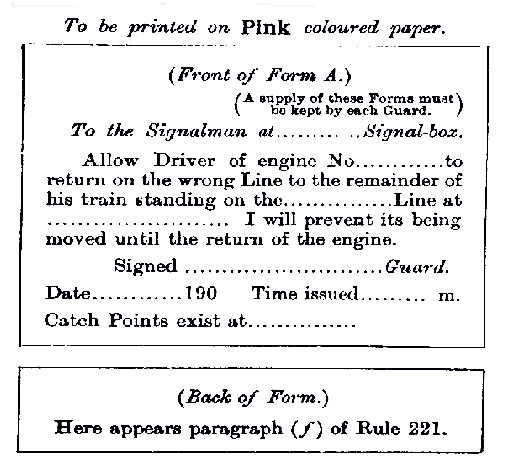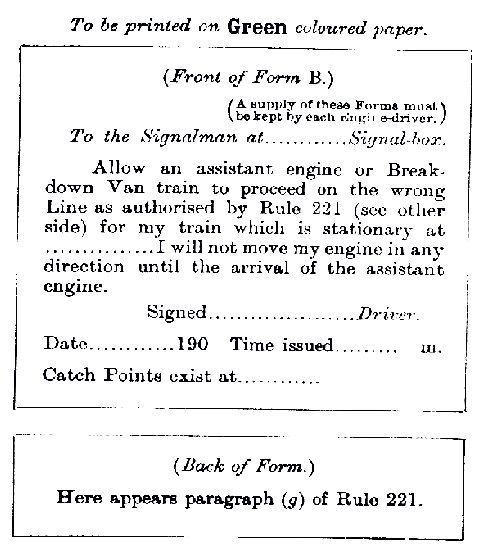223. When moving in the wrong direction, as laid down in Rules 221 and 222, the engine-driver must send his Fireman on foot in front of the engine to warn anyone who may be on the Line that the engine or Breakdown Van train is approaching on the wrong Line. The Engine-driver must then proceed cautiously, travel at reduced speed, and make frequent use of the engine whistle.
224. Should Catch Points exist, arrangements must be made for securing them as shown in Rule 236, and Engine-drivers, when authorised to travel in the wrong direction under the circumstances referred to in Rules 221 and 222, must not pass over such Catch Points in the wrong direction until they have assured themselves that they are held or secured in their proper position for the train to run over them. Signalmen must, before authorising Engine-drivers to run in the wrong direction, remind them of the existence of the catch Points.
225. (a) In the event of any failure of, or accident to, some part of a train, it will generally be found desirable to bring the train to a stand as quickly as possible, but whether this course can be taken with safety, and how the stoppage can best be effected, must depend on the nature of the mishap to the train, the weight and speed of the train, the gradients, curves, and other conditions applying to the Line, particularly as regards the positions of Points and Crossings. In all cases when the whole of the train remains upon the rails, it must be brought to a stand as quickly as possible.
(b) If the engine be defective, the sooner the train can be stopped the better. If any of the vehicles be off the rails the breaks in the rear must be instantly applied, in order that by keeping the couplings tight the disabled vehicles may be kept up and out of the way of the vehicles behind until the force of the latter is exhausted, it being desirable that the front portion of the train should be brought slowly to a stand. The application of the front breaks might result in further damage, and great care must be exercised in their application. In all cases the application of breaks behind a disabled vehicle, or the application by the Guard of the Continuous Break at the rear of a train, will be attended with advantage, and Rear Guards of trains fitted with the Continuous Break must apply the Continuous Break as well as the Hand-break.
(c) In the event of the Rear Guard not promptly applying the breaks when the Engine-driver whistles for them, the Engine-driver must, if his train is fitted with the Continuous Break, apply the same gradually, and with judgment and care.
(d) Shoud any part of the train on which the Continuos Break is not in operation become detached when in motion, care must be taken not to stop the front part of the train before the rear portion has either been stopped or is running slowly, and the Rear Guard must promptly apply his break to prevent a collision with the front portion.
(e) In all cases Engine-drivers and Guards must act according to the best of their judgment and ability in the circumstances inwhich they are placed.
226. Should any vehicle in a train be on fire the train must be stopped, and, if not protected by fixed signals, the Guard must protect it in compliance with Rule 217. The Under Guard, or the Fireman if there be no Under Guard, must detach the vehicles in the rear of those on fire; the burning vehicles must be drawn forward to a distance of fifty yards at least, then uncoupled, and left properly secured, until the fire can be extinguished, to effect which every effort must be made.
221. (a) When a train or portion of a train is left on any Running Line from accident or inability of the engine to take the whole forward, or from any other cause, the Engine-driver must not return for it on the same Line, except as ordered in clauses (f) and (g) of this Rule, but he must cross on to, and travel along, the proper Line, and must re-cross at the nearest point behind the part left, which he must push before him until convenient to go in front again with the engine. If there be a Crossover road immediately in front of the train, and the operation can be performed within sight of the Signal-man, the Driver must use such Crossover road for the purpose of attaching his engine in front of the train.
(b) In cases where it is necessary to divide a Goods train on an incline, owing to the inability of the engine to take the whole forward, both portions must, when practicable, be worked up the incline with a Break-van in the rear. When a train is divided in this way at a Station, or at an intermediate Signal-box, where a portion of the train can be disposed of, it will generally be found most convenient to shunt the front portion of the train into a Siding, and take the rear portion forward first (with the break-van attached in rear) to the next Station or Signal-box where there are means of disposing of it.
After the first portion of the train has been disposed of, the engine must return on the proper Line with the break-van, for the purpose of working forward the other portion of the train, which has been left behind, and the break-van must, in that case also, be attached in the rear.
(c) Unless both portions of the train are worked forward with a break-van in the rear, a Tail Lamp must not be carried on the engine or last vehicle of the front portion of the train before reaching the first Signal-box, where the Engine-driver must stop and inform the Signalman of the position of matters; if the engine or front portion of the train has to pass into the next Section a Tail Lamp must the be placed in the rear. The Signalman must not give "Train out of Section" to the Signal-box in the rear until he has satisfied himself that the whole of the train has arrived.
After sunset, or in foggy weather or during falling snow, before the front portion is drawn forward, a White Light must be exhibited of the front vehicle of the rear portion by the man who divides the train.
(d) When two Guards are employed with the train the front Guard (or where both Guards ride in the rear, the Under Guard) must uncouple it, and ride upon the last vehicle of the front portion; the other Guard, after putting on his break, and securing the last portion of the train so that it will remain stationary, must go back and protect it in accordance with Rule 217.
(e) When there is only one Guard with the train the Fireman must ride upon the last vehicle of the front portion, and the Guard must take the necessary measures to protect the last portion.
WITHOUT A CROSSOVER ROAD
(F) If it be found necessary to return to the train or rear portion of the train on the wrong Line, the Engine-driver must, before starting with the front portion, send his Fireman to the Guard to obtain his written authority to the Signalman at the nearest Signal-box in advance where the front portion of the train can be put away, authorising him to allow the engine to return from that point on the wrong Line (see Form A at end of Rule), and without this authority the Signalman must not allow the engine to return on the wrong Line to its train. The Signalman must retain this Order. Should there, however, be an intermediate Signal-box, the Order held by the Engine-driver must be retained by him and shown to the Signalman there when running in the wrong direction, and given up to the Signalman at the place where the front portion of the train has been put away, when he arrives there with the second portion. After giving such instructions the Guard must continue to protect his train in the rear, and prevent a following train from pushing it ahead.
WITH A CROSSOVER ROAD
If there is an intermediate Signal-box provided with a Crossover road between the point where the rear portion of the train is left on the Running Line and the Signal-box to which the front portion of the train will have to go to be disposed of, the "Wrong Line" order must be made out by the Guard to the Signalman at such intermediate Box, and the Driver, after leaving the order with the Signalman there, must proceed to the place where he can dispose of his train, and then return on the proper Line of rails to the intermediate Box, and there be crossed onto the line on which the rear portion of his train is standing, so that the engine shall not travel on the wrong Line further than is absolutely necessary.
(g) When a train is brought to a stand on any Running line, owing to the failure of the engine, or from any other cause, and the Guard has gone to the rear to protect it, it may be necessary for the engine coming to the assistance of the train, or for the Breakdown Van train, to travel on the wrong Line from the Signal-box in advance. In such a case the Engine-driver of the disabled train must write out an authority (on Form B where in use, see end of Rule), for the Signalman at the box in advance to allow the assistant engine, or the Breakdown Van train, to travel on the wrong Line to the disabled train. The Fireman of the disabled train must hand the written authority to the Signalman, and accompany the assistant engine, or the Breakdown Van train, to his train, advising the Engine-drive where, and under what circumstances, the disabled train is situated, and the Signalman must show the authority to the Driver before allowing the assistant engine or Breakdown Van train to proceed on the wrong Line. The Engine-driver of the disabled train, after giving the order for the assistant engine or the Breakdown Van train to run on the wrong Line, must not allow his train to be moved until the assistant engine or the Breakdown Van train arrives, unless satisfactory arrangements have been previously made to prevent the assistant engine or Breakdown Van train from coming on the wrong Line, and his Fireman has returned and handed the "Wrong Line" order back to the Engine Driver.
(h) Should there be any intermediate Signal-box without a Crossover road, the Fireman, when going for assistance, must show the written authority (on Form B where in use) to the Signalman at that box.
(i) The Engine-driver, when returning for the portion of his train that has been left behind, or when pushing such portion of his train, or the Driver of the assistant engine or the Breakdown Van train, as the case may be, must not pass any Signal-box without the permission of the Signalman.
(j) If, after a train has become accidently divided, both portions have been brought to a stand within sight of each other, and there is not a Signal-box near either end of the train, the front portion may be set back to the rear portion, provided the two portions can be re-coupled; but, before moving, the Engine-driver must send his fireman to the Guard who is protecting the rear portion, for a written authority to set back.


